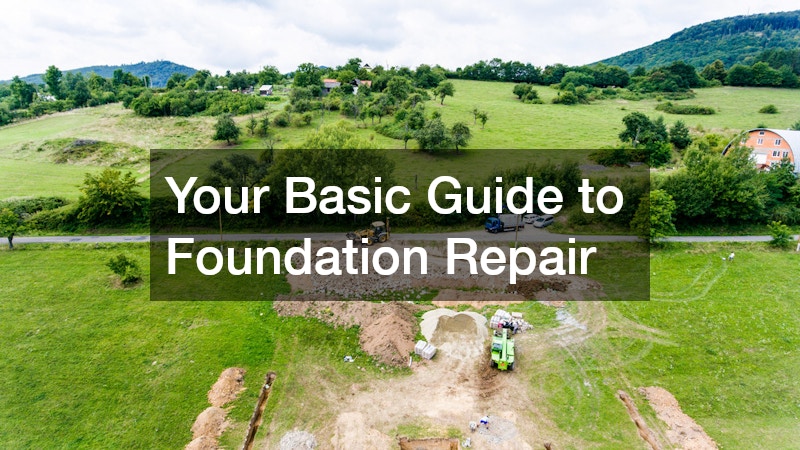Foundation repair is a critical area of home maintenance that ensures the structural integrity and safety of your property. Understanding the basics can help homeowners identify issues early and take appropriate action. This guide aims to answer the most common questions and provide a comprehensive overview of foundation repair.
1. Identifying Early Warning Signs
Foundation problems often manifest through visible symptoms such as cracks in walls, uneven floors, and doors or windows that don’t close properly. Recognizing these signs can help address issues before they escalate. Homeowners can often notice these signs during regular household activities, thus making early detection possible.
Shifting or expanding soil can exacerbate issues, causing noticeable changes in the foundation’s stability. Over time, even small issues can become significant, leading to costly repairs or irreversible damage if not addressed promptly. Regularly checking for signs of foundation distress is a proactive measure that can save both effort and expense in the long term.
Environmental factors like excessive moisture or drought can significantly impact foundational integrity. Seasonal changes, too, can lead to cycles of expansion and contraction in the soil under a home’s foundation. By understanding these signs, homeowners can engage professionals at the right time to mitigate further risks.

2. Considering Factors Influencing Repair Costs
The cost of foundation repair varies significantly based on the extent of the damage, the methods of repair required, and regional factors. Repair expenses can be influenced by the type of foundation, with slab foundations often differing in cost from pier and beam structures. Factors like accessibility can add to the complexity and cost of a repair job.
Labor and material costs also contribute to the overall expenditure and can vary by location. Homeowners should get multiple assessments to gauge a fair price range for their situation. The magnitude of the damage is often the most significant factor affecting cost, with mild issues requiring less investment than more severe cases.
Poor soil conditions can necessitate more extensive stabilization efforts and raise costs. Using advanced technology or specific repair methods, like underpinning or mud jacking, can also determine the final price. Investing in a comprehensive professional evaluation can help ensure the estimation is accurate and the necessary resources are allocated.
3. Understanding Common Repair Techniques
Several techniques, such as slab jacking, piercing, and underpinning, are employed to repair foundations. Slab jacking involves injecting a grout mixture beneath a sunken concrete slab to elevate it to the desired level. This method is particularly useful for restoring evenness to large concrete floors or driveways.
Piering is another common strategy, using steel posts driven deep into load-bearing soil to lift and secure weakened foundations. This approach is ideal for stabilizing homes with severe settlement issues over shifting soils. By fastening the foundation to sturdy piers, structural integrity can be restored.
Underpinning expands the existing foundation by pouring new concrete beneath it to distribute weight across a broader area. This technique is most suitable for foundations with depth or load distribution issues. Each method is chosen based on specific conditions and requirements, making professional evaluation key for effective repair selection.
4. Assessing When to Seek Professional Help
While minor issues can sometimes be addressed by the homeowner, major or complex foundation problems typically require professional assessment and repair to ensure safety and effectiveness. DIY solutions may offer temporary respite but often lack the durability and precision needed for lasting results. It is crucial to differentiate between cosmetic fixes and structural repairs.
Ignoring significant warning signs can lead to exacerbated problems, increasing repair costs down the line. Professionals bring specialized equipment, experience, and local expertise, ensuring that hidden or underlying issues are not overlooked. Consulting with qualified environments helps avoid unnecessary risks and achieve more sustainable solutions.
Researching the scope of the repair can guide whether DIY is feasible or ill-advised. Smaller repairs, like minor cracks, can occasionally be managed with proper sealing techniques and attentive monitoring. Nonetheless, understanding one’s limitations is crucial, as successful foundation repair is often based on in-depth knowledge of structural behavior and geology.
5. Taking Proactive Measures for Maintenance
Regular maintenance, such as proper drainage solutions and vegetation management, can prevent moisture-related problems and prolong the foundation’s lifespan, averting costly repairs. Ensuring that gutters are clean and downspouts direct water away from the foundation prevents soil erosion and excess moisture. This simple measure can drastically impact the longevity of structural foundations.
Planting trees and shrubs at a safe distance ensures roots do not undermine the foundation. Proper landscaping plays an essential role in managing soil expansion and contraction. Landscaping efforts can sometimes inadvertently disrupt a foundation’s integrity if not planned correctly.
Routine inspections for early detection of issues can also be invaluable. Scheduling periodic professional assessments allows homeowners to take timely corrective action. Protecting the foundation’s integrity is a long-term commitment, demanding active engagement and awareness of environmental changes.
Understanding the fundamentals of foundation repair is vital for maintaining a safe and stable home. By learning the signs of foundation distress and knowing when to call in experts, homeowners can preserve their investment and ensure the long-term durability of their property. Taking informed actions promises peace of mind and a secure living environment well into the future.







